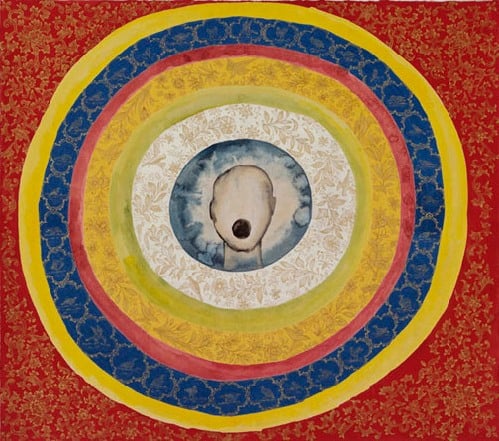
Francesco Clemente, a New York art star of the 1980s, has been inspired by the visual culture of India for decades.
A new show, “Francesco Clemente: Encampment,” takes advantage of the sprawling galleries at the Massachusetts Museum of Contemporary Art to bring together the artist’s devotion to color, craft, sexuality, and symbolism at a grand scale (see Mass MoCA Gets $25.4 Million Grant to Double Gallery Space).
Along with peers like Sandro Chia, Enzo Cucchi, David Salle, and Julian Schnabel, Clemente was acclaimed in the ’80s New York art scene, and broke out onto the public stage at the 1980 Venice Biennale. Clemente’s paintings were featured in Alfonso Cuarón’s 1998 film, Great Expectations, followed by a Guggenheim show in 1999-2000. Many of these artists have since faded from view, to a greater of lesser extent; no major New York museum has given an exhibition to any of the members of this group since the early aughts.
And yet, Clemente has been in the public eye of late, with solo shows at Rome’s Galleria Lorcan O’Neill in 2011, New York’s Mary Boone Gallery in 2012, and New York’s Rubin Museum in 2014-15.
Francesco Clemente, Standing With Truth Tent (2013) (exterior view), tempera on cotton and mixed media.
Photo: Courtesy of the artist and Blain/Southern Gallery, Berlin.
The main gallery of the Mass MoCA show is given over to a series of six brightly painted canvas tents, sprawling over some 30,000 square feet of exhibition space. Measuring as much as 18 feet wide and 12 feet high, the tents might recall refugee camps and headlines about Europe’s migrant crisis, though they are more rooted in Clemente’s own experience of living part-time in India.
The tents are created in collaboration with artisans in Rajasthan, and are decorated inside and out with imagery that tells diverse tales, seemingly aimed at capturing the multiplicity of human experience. While the interiors are hand-painted in acrylic by Clemente, the exteriors are embroidered by Indian artisans based on Clemente’s designs.
Francesco Clemente, Museum Tent (2013) (interior view), tempera on cotton and mixed media.
Photo: Courtesy of the artist and Blain/Southern Gallery, Berlin.
The iconography on one of the structures is devoted to representations of exploitation. Aiming for maximum legibility, Clemente paints a man in a tuxedo, with a monocle no less, holding two shackled humans at the end of a chain; the smoke from his cigarette forms the shape of the African continent.
Another tent, in a starkly different emotional register, is devoted to art and museums. On its exterior, it offers images of the world’s museums, from the Basel Kunstmuseum to the Metropolitan Museum of Art and the Guggenheim; inside are paintings of Clemente self-portraits, complete with painted frames. In one painting, the artist cradles head in hand as he gazes upward at the Earth floating in space, as if to take on the most expansive of philosophical questions; in another, in a perverse act of self-effacement, the artist hangs by a noose, his tongue lolling out.
In a mezzanine upstairs are some of the most visually riveting works in the show. These 19 watercolors, small and packing a real visual punch, might represent a distillation of the sprawling tent paintings. They are inspired by Mughal miniature painting, and combine floral patterns with, at times, startlingly sexual and gruesome imagery.
Francesco Clemente, No Mud, No Lotus series (2013-2014), watercolor and miniature on handmade paper.
Photo: Courtesy of the artist.
In one image, two men simultaneously penetrate a woman; all are standing, viewed in profile, their bodies visually defined by floral patterns, hers given over to washy watercolor.
Another image combines cunnilingus with a doubting Thomas motif; a female midsection, nipples and genitals clearly defined, sports a gaping red wound in its side; a man’s head enters from the left and inserts a greedy tongue into the injury.
Francesco Clemente, Hunger (2014), fabric, embroidery, bamboo, aluminum, iron.
Photo: Courtesy of the artist.
Clemente doesn’t have modest aims for his work. An embroidered flag that forms part of one of his sculptures is emblazoned with words from French theorist Guy Debord: “The spectator feels at home nowhere because the spectacle is everywhere.” In connection with this work, Clemente has said that the goal is “to direct humanity toward an image that heals, instead of an image that weakens.”
The artist’s broad symbolism might seem simplistic to contemporary art audiences more accustomed to cerebral, research-based work, and his stated sincerity can appear out of step with the ironic tone that characterizes so much art of today. But you can’t help but admire his ambition.
“Francesco Clemente: Encampment” is on view at the Massachusetts Museum of Contemporary Art through early January 2016.